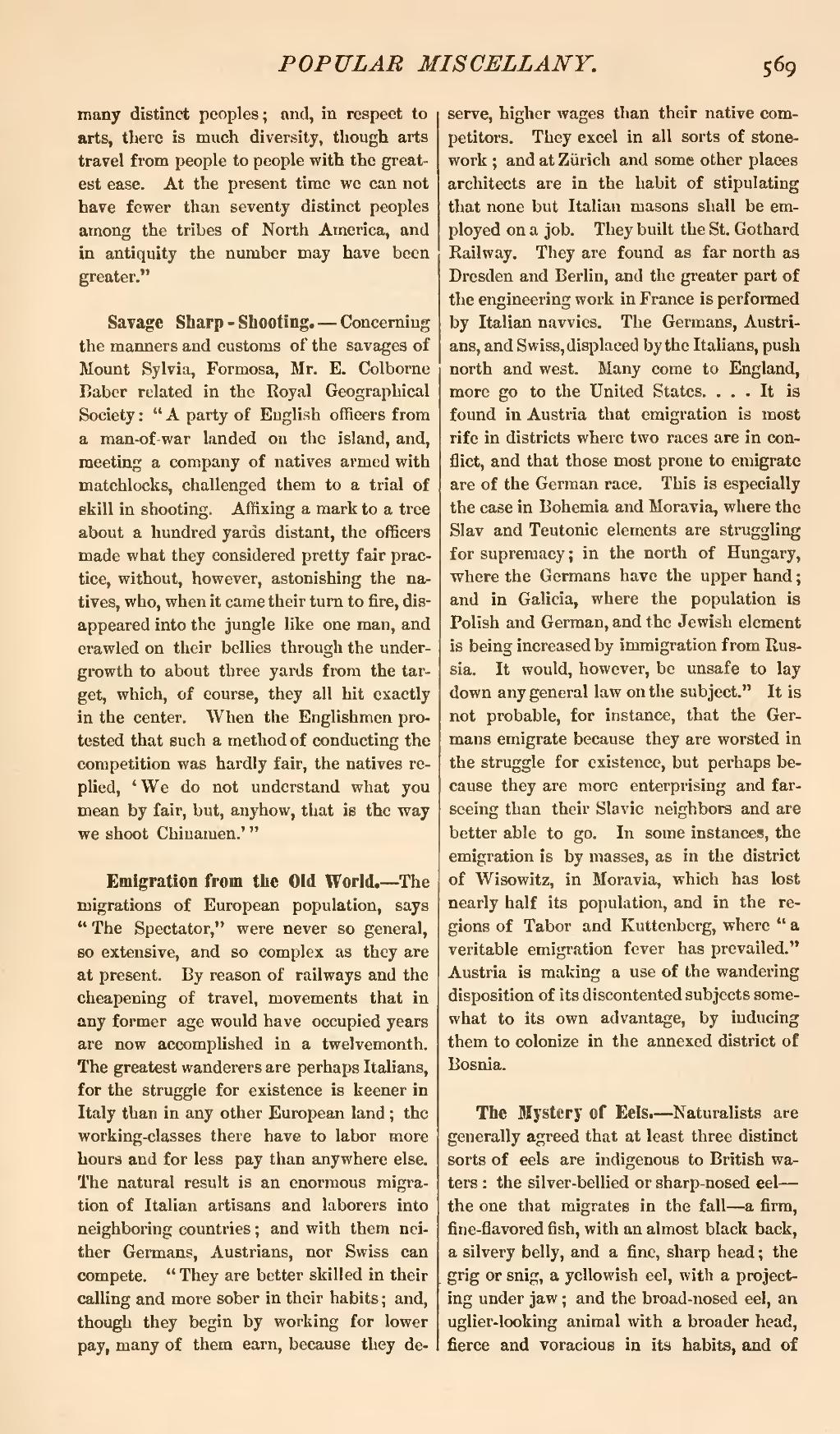many distinct peoples; and, in respect to arts, there is much diversity, though arts travel from people to people with the greatest ease. At the present time we can not have fewer than seventy distinct peoples among the tribes of North America, and in antiquity the number may have been greater."
Savage Sharp-Shooting.—Concerning the manners and customs of the savages of Mount Sylvia, Formosa, Mr. E. Colborne Baber related in the Royal Geographical Society: "A party of English officers from a man-of-war landed on the island, and, meeting a company of natives armed with matchlocks, challenged them to a trial of skill in shooting. Affixing a mark to a tree about a hundred yards distant, the officers made what they considered pretty fair practice, without, however, astonishing the natives, who, when it came their turn to fire, disappeared into the jungle like one man, and crawled on their bellies through the undergrowth to about three yards from the target, which, of course, they all hit exactly in the center. When the Englishmen protested that such a method of conducting the competition was hardly fair, the natives replied, 'We do not understand what you mean by fair, but, anyhow, that is the way we shoot Chinamen.'"
Emigration from the Old World.—The migrations of European population, says "The Spectator," were never so general, so extensive, and so complex as they are at present. By reason of railways and the cheapening of travel, movements that in any former age would have occupied years are now accomplished in a twelvemonth. The greatest wanderers are perhaps Italians, for the struggle for existence is keener in Italy than in any other European land; the working-classes there have to labor more hours and for less pay than anywhere else. The natural result is an enormous migration of Italian artisans and laborers into neighboring countries; and with them neither Germans, Austrians, nor Swiss can compete. "They are better skilled in their calling and more sober in their habits; and, though they begin by working for lower pay, many of them earn, because they deserve, higher wages than their native competitors. They excel in all sorts of stonework; and at Z—rich and some other places architects are in the habit of stipulating that none but Italian masons shall be employed on a job. They built the St. Gothard Railway. They are found as far north as Dresden and Berlin, and the greater part of the engineering work in France is performed by Italian navvies. The Germans, Austrians, and Swiss, displaced by the Italians, push north and west. Many come to England, more go to the United States. . . . It is found in Austria that emigration is most rife in districts where two races are in conflict, and that those most prone to emigrate are of the German race. This is especially the case in Bohemia and Moravia, where the Slav and Teutonic elements are struggling for supremacy; in the north of Hungary, where the Germans have the upper hand; and in Galicia, where the population is Polish and German, and the Jewish element is being increased by immigration from Russia. It would, however, be unsafe to lay down any general law on the subject." It is not probable, for instance, that the Germans emigrate because they are worsted in the struggle for existence, but perhaps because they are more enterprising and farseeing than their Slavic neighbors and are better able to go. In some instances, the emigration is by masses, as in the district of Wisowitz, in Moravia, which has lost nearly half its population, and in the regions of Tabor and Kuttenberg, where "a veritable emigration fever has prevailed." Austria is making a use of the wandering disposition of its discontented subjects somewhat to its own advantage, by inducing them to colonize in the annexed district of Bosnia.
The Mystery of Eels.—Naturalists are generally agreed that at least three distinct sorts of eels are indigenous to British waters: the silver-bellied or sharp-nosed eel—the one that migrates in the fall—a firm, fine-flavored fish, with an almost black back, a silvery belly, and a fine, sharp head; the grig or snig, a yellowish eel, with a projecting under jaw; and the broad-nosed eel, an uglier-looking animal with a broader head, fierce and voracious in its habits, and of
